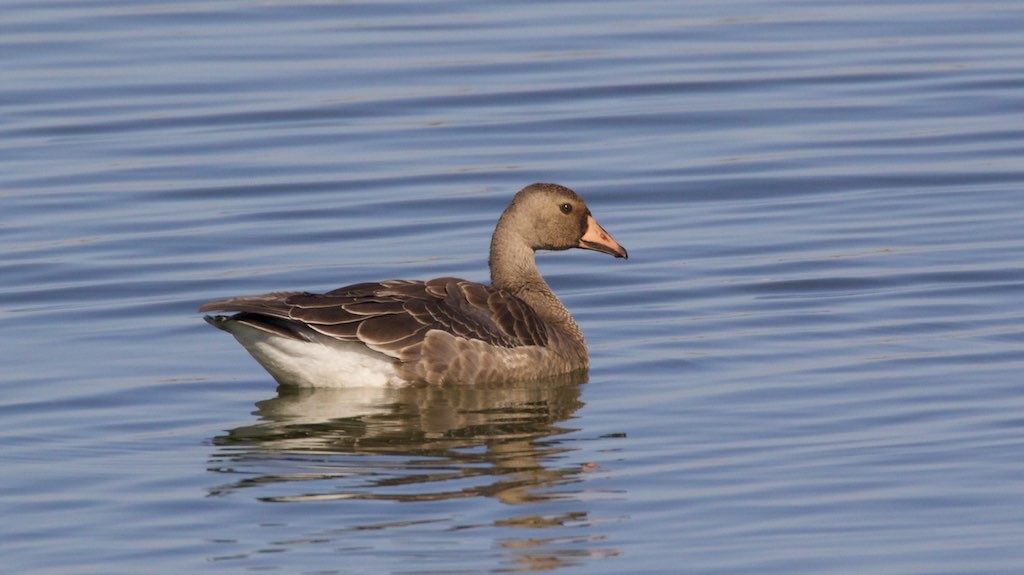Greater White-fronted Goose
A species of Grey And White Geese, Also known as Specklebelly Scientific name : Anser albifrons Genus : Grey And White Geese
Greater White-fronted Goose, A species of Grey And White Geese
Also known as:
Specklebelly
Botanical name: Anser albifrons
Genus: Grey And White Geese
Description
Greater white-fronted geese are 64–81 cm (25–32 in) in length, have a 130–165 cm (51–65 in) wingspan, and weigh 1.93–3.31 kg (4 lb 4 oz–7 lb 5 oz). They have bright orange legs and mouse-coloured upper wing-coverts. They are smaller than greylag geese. As well as being larger than the lesser white-fronted goose, the greater white-fronted goose lacks the yellow eye-ring of that species, and the white facial blaze does not extend upwards so far as in lesser. The male is typical larger in size, both sexes are similar in appearance—greyish brown birds with light grey breasts dappled with dark brown to black blotches and bars. Both males and females also have a pinkish bill and orange legs and feet. Greater white-fronted geese make a variation of sounds, but notably the most recognizable is the high pitched cackle that can be imitated by the sounds "he-he." There is a distinct breaking of the note from the first cackle to the second. 
Size
66-86 cm (26-34 in)
Colors
Brown
Black
Gray
White
Orange
Life Expectancy
18 years
Nest Placement
Ground
Clutch Size
1 - 8 eggs
Incubation Period
1 brood
Number of Broods
22 - 27 days
Nestling Period
1 - 2 days
Feeding Habits
Greater White-fronted Goose primarily consume sedges, grasses, berries, and tubers in summer, while in winter, their diet shifts to seeds, grain, and grasses. They display pecking behavior to feed on vegetation, stems, and pluck plants' tubers, seeds, or grains. In aquatic environments, greater White-fronted Goose feed on emergent vegetation and submerge to reach underwater plants.
Habitat
Greater White-fronted Goose typically inhabits a range of wetland environments including marshes, prairies, and fields near water bodies like lakes and bays. In summer, they prefer the tundra, utilizing the adjacent wetlands, rivers, and ponds. These geese adapt to various altitudes during migration, seeking out wet sedge meadows, tidal mudflats, and freshwater sources. Winter habitats involve open lakes and ponds for roosting, with daytime foraging in agricultural fields of barley, oats, corn, rice, and wheat. Climate preferences are diverse, spanning from the Arctic breeding grounds to temperate wintering areas.
Nest Behavior
Greater White-fronted Goose selects a nest site, creates a depression, and lines it with vegetation and down. Nest-building peaks in spring. Egg-laying is sequential, with diligent incubation by the female, while the male stands guard nearby.
Nest Characteristics
Greater White-fronted Goose's nests are ground scrapes located in grassy, sedge-rich, or shrubby areas. Commonly wet near lakeshores or in upland tundra, they are lined with grass, sedge, and feathers, forming a well-insulated bowl.
Dite type
Herbivorous
People often ask
Migration Overview
Midcontinental white-fronted geese in North America have many breeding areas and each group in each breeding area differs in its migration time and wintering location. There are six breeding areas, including interior Alaska, the North Slope of Alaska, western Northwest Territories, western Nunavut, central Nunavut, and eastern Nunavut. These spatial differences lead to different departure times for white-fronted geese leaving their breeding areas. Birds from interior Alaska start migrating earlier during autumn and fly farther south to winter. Due to their migration, white-fronted geese are commonly sought after by waterfowl hunters, all across the country. 
General Info
Feeding Habits
Bird food type
Sounds
Call
Recording location: Belgium
Call
Recording location: Belgium
Call
Recording location: Netherlands
Behavior
Greater White-fronted Goose are highly social and exhibit strong flight skills, commonly seen in 'V' formations or lines, with a distinctive high-pitched call. These adaptive foragers gracefully graze on various vegetation, both on land and in water, through methods like dabbling. Outside their breeding season, greater White-fronted Goose congregate in flocks yet become territorial family units when nesting, using postures and aggression to defend against threats. They form lasting pair bonds and maintain family groups, with offspring participating in nest defense. Remarkably, greater White-fronted Goose showcase site fidelity, returning to familiar breeding and wintering grounds annually, with juveniles dispersing after reaching maturity at 2.5 years.
Distribution Area
The North American midcontinent birds of the subspecies A. a. gambeli – which in 2010 had a fall population of about 710,000 birds – breeds from the Alaska North Slope across the western and central Canadian Arctic. The Pacific white-fronted goose of the American Pacific coast, which in 2010 numbered approximately 650,000 birds, and the tule geese, which are estimated to number 10,000 birds, nest in western Alaska. The midcontinent geese gather in early fall on the prairies of western Saskatchewan and eastern Alberta, spending several weeks feeding before heading to wintering areas near the Gulf of Mexico, into northern Mexico. The Pacific birds migrate south down the Pacific coast, staging primarily in the Klamath Basin of southern Oregon and northern California and wintering, eventually, in California's Central Valley. The tule goose is somewhat rare and has been since the latter half of the 19th century, presumably it was affected by destruction of its wintering habitat due to human settlement. In the British Isles, two races overwinter: Greenland birds in Scotland and Ireland, and Russian birds in England and Wales. They gather on farmland at favoured traditional sites, with a famous flock gathering at WWT Slimbridge, Gloucestershire, England. Greenland birds also overwinter in Ireland and from late September and through the winter months, Ireland is home to almost 50% of the Greenland population of white-fronted geese. A. a. albifrons and A. a. flavirostis are among the taxa to which the Agreement on the Conservation of African-Eurasian Migratory Waterbirds (AEWA) applies. 
Species Status
Not globally threatened.
Scientific Classification
Phylum
Chordates Class
Birds Order
Waterfowl Family
Geese Genus
Grey And White Geese Species
Greater White-fronted Goose 